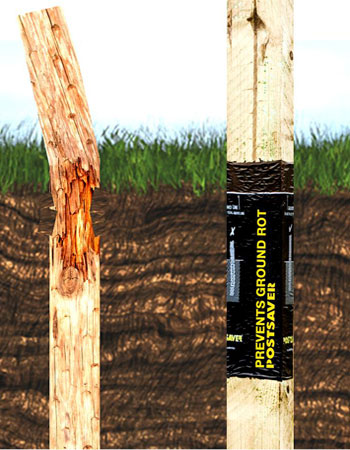Wooden fencing rots because of biological decomposition which takes place in damp conditions. The process is fairly complex.
It starts with soluble organic compounds in the wood leaching away in water. This is followed by a breakup of the structure of the wood leading to greater porosity and increasing the surface area. This leaves the wood more vulnerable to attack by microbes which begin to colonise it. Next the wood is attacked by various parasitic life forms, for instance insects such as termites, and fungi of various kinds. The wood is also attacked by various detritivores such as millipedes, wood lice, and worms. The rate of decay depends on warmth and dampness; the warmer and damper the wood, the faster the rate of decay.
Altogether this isn’t a pretty picture, but there is a lot we can do to prevent it happening or at least to slow it down considerable. The first thing to consider is that different species of wood rot at different rates. For instance yew is highly resistant to rot, cedar and white oak are resistant, white pine is moderately resistant, and pine, birch, and ash have very little resistance and rot very quickly. The woods listed above that are resistant are the heartwoods, which is wood taken from the heart, or inner part, of the tree. Wood taken from the outer parts of the tree are called sapwoods as they transport water; sapwoods of all tree species have very low rot resistance.
Preventing wood from rotting
So how do we prevent wood from just rotting? The answer is to treat the wood with chemical preservatives that prevent or slow down biological attack. The main methods are pressure treating the wood with creosote, pentachlorophenol, or inorganic arsenical chemicals, the most common of which is chromated copper arsenate (CCA). While these chemicals protect the sapwoods, they are unable to penetrate the heartwoods, and so it is advisable to seal pressure treated wood after it has been sawn.
Other forms of wood treatments that are applied to the surface of wood by painting or spraying include linseed oil, creosote, and numerous commercial preservatives that contain antifungal chemical and insecticides. These protect only the outer layers of the wood and need re-application every few years.

Fence Posts and Postsavers
While you can maintain the appearance of your fence and provide an extra degree of protection from the elements by treating it with the paintable and spray-able products mentioned above, the most vulnerable parts of your fence are the parts you can’t see, the parts of the fence posts that are buried in the ground.
These are subject to the ideal conditions needed to accelerate rot, and even fence posts that have been pressure treated with the latest wood preservatives are vulnerable. Wooden fence posts tend to rot at ground level and this can happen surprisingly quickly, especially in damp poorly drained conditions, with the result that you might need to replace your expensive fence after just a few years, but it doesn’t have to be the case.
At Weald Fencing we ensure this isn’t something our customers have to put up with. All our fence posts are installed using Postsaver, which is a special sleeve with a meltable bituminous liner. The liners fits round the posts at ground level, and we heat shrink them to the posts to form an impenetrable barrier. This prevents the preservatives from leaching out of the wood, keeping them inside where they can continue to do their job preventing decay, and protects the wood from attack by termites and other life forms. Postsavers can protect fence posts from rot for 25 years.
